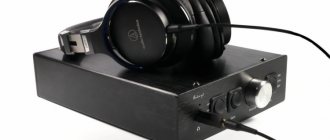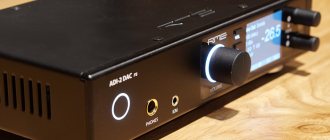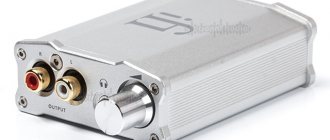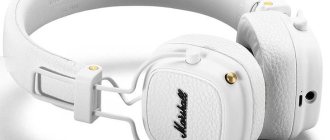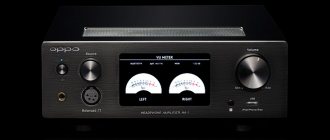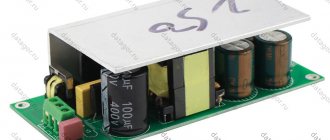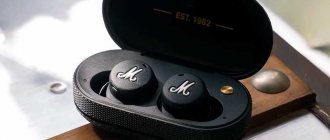The line of DACs/headphone amplifiers in the desktop/portable segment of the British company iFi is headed by a new flagship clad in a Space Blue body, the circuits of which provide a noise level comparable to cosmic silence, on which its sound quality is based.
Save and read later -
The component is clad in an elongated metal case in Space Blue color. There are small rubber feet on the bottom, and the kit includes an anti-slip and anti-vibration mat
What goes with it?
With any headphones, as well as with components equipped with analog inputs
The USB port (type C) on the right side is for charging the battery. An LED indicator next to it indicates the charge level. The kit includes a short cable for connecting to a computer USB port or charger
Somehow it so happened that recently the authors of this review have mostly passed through the hands of portable devices - players, DACs / headphone amplifiers, and even earbuds - from south-eastern brands. It is all the more interesting to get acquainted with the European product, the new flagship of the corresponding line of the British company iFi Audio, a desktop device designed to act as an intermediary between the computer and the headphones on the user’s head with the noble mission of filling his favorite music with energy.
A smartphone (tablet) can also act as a content source and player. The kit includes a pair of round rubber holders for combining them with the Micro iDSD Signature into one, but you can hardly fit such a bundle into your pocket - the dimensions of the device are too large for this. To connect Apple gadgets to its USB port, you need a Lightning to USB Camera Adapter, and for those running Android OS, you need one that is compatible with OTG technology.
This iFi DAC/headphone amplifier has a built-in 4800 mAh battery and is ready to operate up to 12 hours (depending on the type of headphones and digital stream settings) independently. But this, so to speak, is a by-product of such a design solution; its main goal is to provide clean power to all circuits of this DAC/headphone amplifier, independent of the instability of mains electricity.
The bottom panel of the case briefly informs about the main characteristics of the component, as well as the purpose of the controls and inputs/outputs
Sound
The following headphones were used to listen to the device: iBasso IT04, Meze 99 Classics, Audio Zenith PMx2, Noble Kaiser Encore, Campfire Audio Andromeda, Unique Melody Mason V3, HUM Pristine and others.
Unlike xDSD, which slightly emphasizes the bass, iDSD Black Label is tuned in a more neutral, audiophile style. I think the name iDSD Pro would have suited it very well, but iFi decided that their stationary line would get the Pro prefix.
The bass here is fast, conveys textures well and perfectly separates instruments. It is perfectly controlled, which is not surprising with such power, and is distinguished by whiplash, impact and very decent depth. In general, almost ideal low frequencies for fans of their monitor presentation without “piling up” (of course, artificial, when there is a fair amount of bass in the recording, the BL will give it to you in the same quantities). The Xbass+ function surprisingly works very neatly, it slightly emphasizes the deep bass, which adds a little “monumentality” to the sound, but does this without excessive emphasis, leading to smearing of the low frequencies. In general, this is not a typical boost in the style of “turned it on, everything hummed, Satan woke up.”
The midrange is also presented in a neutral key, but without excessive dry monitoring and unnatural accentuation of micro-contrast. The combine perfectly conveys all the nuances and emotions embedded in the recording, but does not add anything of its own, so high-quality tracks are almost an absolute necessity. The gadget perfectly reproduces the character of instruments and all the features of vocalists of both sexes. The imaginary stage is larger than average in depth and width, not gigantic, but very good. By default, the width is slightly greater than the depth, but turning on the 3D+ function adds a little depth, but the separation of shots becomes a little unnatural, so I would advise using this feature only with old recordings with poor mixing.
The upper frequencies are neutral, they have normal resolution and a very decent extension. Perhaps this is the only part of the range that one can hardly find fault with; iDSD BL lacks “layering” quite a bit, and attacks and decays are also somewhat simplified, but this is compared to the top segment of audio equipment. In general, the high frequencies are very natural, without a touch of synthetics, so they cope with their tasks at a good level.
And, of course, about comparisons. I’m deliberately omitting functionality, since iFi is probably beyond competition here and I’ll talk exclusively about sound.
iFi xDSD Overall, the two portable DACs from iFi are positioned very differently, but the questions “how do they compare?” they will still be there. xDSD is distinguished by a warmer presentation, with a slightly lower resolution, but with a slight additional weight in the midrange (especially in the lower part), so here we have the classic opposition “monitoriness VS warmth”.
Hidizs DH1000 A very interesting portable DAC from Hidizs, captivating primarily with its excellent high frequencies. The rest of the range is dominated by iDSD, and that's not to mention power. However, the price difference here is not even 2 times.
FiiO Q5 If we put aside prices, wireless technologies and power, then FiiO has a little better developed high frequencies (although also not quite ideal), in terms of low frequencies there is approximate parity (but due to the power, iDSD is often able to play this range more confidently, so the difference depends on headphones). At mid frequencies, Black Label takes the lead due to better weight and dynamics.
CEntrance BlueDAC Of course, these two devices are incomparable in design and capabilities, so it’s purely about sound. BlueDAC is a little more detailed, but even more neutral and picky about recording quality. CEntrance has better highs, they have approximately parity in the mids, but the lower part of the range sounds tastier and more interesting with iDSD.
The digital side of things
The digital part of the device is based on two Burr-Brown DSD1793 digital-to-analog conversion chips, configured in the “interleaved” mode proposed by iFi specialists, thanks to which the DAC unit operates with four pairs of differential signals - two per channel. This results in lower noise levels, better channel separation, as well as fine musical detail and superior microdynamics. Micro iDSD Signature is capable of working with digital streams in PCM, DXD and DSD formats with sampling parameters up to 32 bit/768 kHz and up to DSD512, respectively. There is also built-in MQA support. Their conversion is performed in “as is” (Native) mode.
The highest possible quality of operation of the DAC unit is guaranteed by the proprietary GMT (Global Master Timing) clock generator installed in the device, which produces signals with femtosecond accuracy. The use of intelligent buffer memory in the circuit is also aimed at reducing jitter levels.
Indispensable for digital-to-analog conversion, filtering is performed using a proprietary (or rather, proposed by the parent company AMR) GTO (Gibbs Transient Optimized) digital filter, which is said to take into account the peculiarities of auditory perception of sound. Additionally, there are filters for the user to choose from, including for DSD streams.
For connecting headphones there is a 6.3 mm jack and a 4.4 mm balanced jack. The device is turned on using the round volume control knob. The LED indicator lights up and its color indicates the sampling frequency and the type of digital stream supplied to the input
Compatibility
In terms of working with a varied load, the hero of today's review confidently holds the absolute palm in the portable. For tight and high-resistance models, it has a turbo mode that produces an exorbitant amount of power. Some users even listened to it with HiFiMan HE-6, noting not ideal, but generally tolerable disclosure, but, of course, this is a clinical case and most headphones are still much more sensitive. But what really deserves respect is the built-in IEMatch, which allows you to listen to even sensitive IEMs without any problems like background noise. The main thing here is to look at the switches before turning them on, as a drop of nicotine will kill a horse and tear a hamster to pieces. This combine is also capable of handling sensitive IEMs in turbo mode.
Stylistically, the device is absolutely universal, provided that you like a neutral presentation that leaves you alone with headphones and recording. The sensitivity to the quality of the material is high, about 8 points out of 10.
According to tradition, several tracks as an example
Five Finger Death Punch - Lift Me Up Well, for starters, just a track that demonstrates excellent control of all frequencies: separation of guitar parts, a tight rhythm section, energetic vocals - everything you need for an excellent “cut”.
Cold War Kids — Love is Mystical An excellent example of slightly pop rock, mixed with many related genres, demonstrates the strengths of iDSD: powerful hits, light midrange, excellent control of the entire range.
Beastie Boys - Sabotage To expand the range, let's take a completely non-audiophile track, however, carefully remastered in 2005. Here the hero of today's review also shows his best side, unleashing crushing blows on the listener in combination with effective scratches.
With any headphones
As emphasized on the company's website, Micro iDSD Signature is ready to work with any headphones - from ultra-sensitive in-ear headphones to planar ones that require high currents. You can optimize the operation of the corresponding block using the gain mode switch: Eco, Normal or Turbo. And for monitor earbuds, IEMatch technology has been proposed, which allows, depending on the position of the switch, to ensure a balance between detail and the level of the noise background of the signal.
This iFi device has a balanced headphone output, but the amplification circuit topology is unbalanced. The developers see certain advantages in it, and in order to provide the user with the benefits of such a connection, they proposed S-Balanced technology for the output stage.
The component uses the highest class components, as well as custom operational amplifiers. The signal path has been carefully optimized and capacitors have been eliminated at the output. All these measures are aimed at ensuring the purity and musicality of the audio signal entering the headphone jacks.
On the rear panel there are digital inputs: 3.5 mm coaxial/optical (adapter included) standard S/PDIF and USB 3.0 (type A), as well as analog outputs, to which you can connect active speakers or an amplifier
Shameless correction
The idea of increasing compactness through hybrid solutions affected not only switching, but also settings. The sound character can be adjusted using a three-position filter that operates in three completely different modes. Its positions are marked as Bit-Perfect, Minimum Phase and Standard, but this layout is only relevant for digital filtering when processing PCM. Interestingly, the instructions recommend listening to music on Bit-Perfect, and taking measurements on Standard.
If the source reproduces DSD, then the selector positions should be understood as Extreme, Extended and Standard, and we are talking about the nuances of analog filtering. In this case, everyone is recommended to figure out their sound preferences on their own, but it’s better to measure parameters again in Standard.
And finally, when processing DXD, the system simply does not work, passing the signal directly in any position.
Other selectors allow you to change the global phase of the signal, disable the preamp output level control, switch the gain, and even turn on the attenuator to match particularly sensitive in-ear headphones.
On the miniature front panel, among other things, there were two high-quality toggle switches, including proprietary 3D Plus and Xbass Plus effects. The first, in terms of its effect on sound, is strongly reminiscent of a stereo widening system, and the second, as you might guess, is responsible for enhancing the bass. Where else can you find so many ways to influence the sound?
Balanced and highly detailed
When testing, the Micro iDSD Signature partners were Sony IER-M7 in-ear monitor headphones and Oppo PM-3 on-ear monitor headphones, and the generator of digital audio streams was a laptop running Windows 10 and the Foobar2000 software player. To fully work with recordings in Hi-Res audio formats, it turned out to be necessary to download it from the iFi Audio website and install a proprietary driver.
The Sony IER-M7 can be connected with both unbalanced and balanced cables, so it’s easy to check how different the corresponding outputs of the component you are listening to are in terms of sound quality. As expected, there is a difference between them, but not as significant as in other similar devices we are familiar with, so owners of high-end headphones will not have to be so upset about the lack of a symmetrical connection. In any case, the sound is balanced, energetic, very detailed and sophisticated, endowed with deep bass, which can also be added with weight using the XBass+ toggle switch located on the front panel.
However, when connecting the IER-M7 to the 4.4mm output, there is a clear sense of increased scale in the headspace, meticulousness in bringing out the smallest sonic details, carefully rendering each note and imbuing it with an even wider range of overtones. All this makes the presentation of music even more authentic, natural and exciting. The user also has additional settings at his disposal: three digital filters, as well as amplification modes (Power Mode) and IEMatch technology, which performs even more precise matching with sensitive in-ear headphones. Our favorites were Bit-Perfect, Normal and High Sensitivity, respectively.
Playing the FLAC 24/192 recording of Zoltán Kodály's Duo for Violin and Cello, Opus 7, from the Starker Plays Kodaly album is not always a pleasant experience, as it requires flawless reproduction of the voices of these complex instruments. With this audio path it is possible to achieve such precision, timbral richness, subtlety of variations in dynamics and, ultimately, liveliness and authenticity of the performance of this work that the music captivates with its emotional message, and the ear follows with interest all the smallest details: light tapping of bows on strings, touches their fingers in pizzicato, the rustle of the pages of the score being turned, the vibrations of the instrument bodies and the breath of the artists. Focusing is impeccable, but the 3D+ mode allows you to make sound images even more prominent.
The ability to excellently organize a musical stage is demonstrated by “Procession to Execution,” the fourth movement of Berlioz’s “Symphony Fantastique,” recorded in the same format. A large orchestra literally visibly appears in space, groups of instruments are in their places, they play expressively and harmoniously; the winds are full-blooded and loud, but absolutely natural, without any distortion even in the loudest moments; The drumbeat is sharp and elastic. The scale of dynamics is very large: the transition from a moderately quiet beginning to a stormy finale occurs naturally, without spatial shifts, and the detail and elaboration are the same throughout the entire track. The complex rhythmic pattern is accurately recreated - it makes a significant contribution to conveying the sense of tragic doom inherent in this music.
Patricia Kaas' CD-quality live album Toute La Musique sounds particularly good in 3D+ mode. You find yourself in a hall filled with spectators, their applause and enthusiastic screams surround you. The vocals are strong, articulate, lively and full of character, and the instruments complement them organically and richly. Both blues compositions and those where Mademoiselle sings rock are a pleasure - excellent rhythm is important for both genres, and the Micro iDSD Signature is again excellent in this regard.
Magneplanar headphones Oppo PM-3 do not pose a big load for the amplifier, so it turned out to be possible to set the Power Mode switch to Eco mode and not turn the volume knob to maximum - this will drain the battery power more slowly. IEMatch, of course, should be set to Off. They are connected to an unbalanced output and demonstrate very high-quality sound: balanced, very detailed, rich, energetic and natural.
The same concert album by Patricia Kaas is listened to with no less pleasure; the inclusion of XBass+ and 3D+ very organically adds volume to the acoustic space above your head and weightiness to the low-frequency range, so that you want to sing along to the lyrical compositions, and tap your foot to those performed in the cheerful style of hard rock .
The album Jazz At The Pawnshop in the DSD128 format, consonant with the name of the model, delights with the smooth flow of the music, the authentic transmission of the club atmosphere of the recording, the naturalness and timbral richness of the instrument voices, as well as the special relaxed rhythm of many tracks. It was possible to increase energy and performance by switching the gain mode to Normal.
The USB port connector is implemented in an OTG form factor, and the package includes an adapter to USB-B, which is more traditional for Hi-Fi equipment equipped with a DAC. The power signal does not pass through it
Useless little things
Along with the DAC, I decided to test two interesting accessories: the iDefender 3.0 ground loop destroyer and the iSilencer 3.0 USB filter. The first of them is interesting in that it is equipped with a separate input for an external 5 V supply voltage (for example, from the internal battery of the same Micro iDSD) and is thus capable of completely isolating the digital stream from the influence of the source power circuits. The thing is definitely useful, although I was unable to detect the audible effect of its operation on my lovingly rearranged home wiring and battery-equipped equipment.
As for iSilencer 3.0, it is said to be an active noise canceler that "reduces jitter and packet errors" as well as a "USB signal rebalancer," whatever that means. I was initially skeptical about it, since usually when working with high-quality short USB interconnects there is no need for such repeaters.
At first, listening only confirmed its absolute optionality in the path. However, when replacing the QED interconnector with a regular printer cable, starting with the DSD256 stream, the difference still appeared.
With iSilencer, the sound has become slightly more transparent and more accurate in terms of microdynamics: apparently, with a sampling frequency of 12 MHz, switching losses can actually be quite significant. So, if you need to stretch a high-speed USB connection for more than a meter, and even more so with a mediocre cable, such a device will definitely not be superfluous.
Let's sum it up
The iFi Micro iDSD Signature DAC/headphone amplifier will be a reliable and versatile companion for computer audio lovers, be it video soundtracks, games, content from Internet services, or Hi-Res format files prepared by good software players for serious music listening. With it, you won’t have to limit yourself in choosing headphones because of the load they represent. The device can also become a source for active acoustics or a full-fledged Hi-Fi system, not only with a PC, but also with conventional components that have a coaxial or optical digital output.
Its sound deserves the highest praise for its precision and detail, energy and naturalness, as well as the authenticity of its performance of music of all genres. Let's not forget the wide possibilities of customizing it to your taste. We sincerely recommend it.
On the left side there are switches for gain (red), as well as IEMatch technology modes, which provide precise adjustment of the amplification stage for working with sensitive in-ear headphones. Between them is the choice of a digital filter
Pedigree quirks
The prototype of the hero of today's story is interesting because it was developed using the Crowd-Design system. That is, any audiophile who registered on the project’s public pages could express their opinion about the circuit design or functionality of the device. This system differs diametrically from crowdfunding - primarily in that the inhabitants of the online community are asked to share thoughts and ideas with developers, not money. The move, of course, is tempting, but unsafe: we all know that there can be any kind of people on specialized forums, and meaningfully implementing a stream of group audiophile consciousness within one device is a non-trivial task.
However, despite the youth of the brand, iFi developers have plenty of experience, because the company did not materialize out of nowhere, but was spun off from the well-known Abbington Music Research (AMR). Therefore, probably, the “voice of the people” eventually crystallized into a device that was quite favorably received not only by its online creators, but also by ordinary music lovers.
Well, some time after the release of the Micro iDSD, it was decided to pump its design to the maximum - obviously, to please not only tight-fisted adherents of the quality/price ratio, but also radical connoisseurs, for whom saving on sound is much less relevant . So, in fact, the “Black Label” appeared.
Conclusion
iFI never ceases to amaze us! The device was definitely a success. xDSD is convenient, compact, looks stylish, assembly is flawless, and it’s a pleasure to use.
And its main advantages are, of course, the impressive sound, which is available without any wires. And the cost of the device is quite appropriate for the current moment. The price for iFI xDSD in Russian online stores varies around 36,000 rubles. Considering all the advantages of this baby, I recommend it for purchase without a shadow of a doubt. Without thinking twice, I paid for the new product and kept it for myself. Such an audio pet is needed in any home where they love music. My xDSD has already settled down and never tires of delighting me with his wonderful voice.
Pros Sound, kit, appearance, functionality, price
Cons : None.
Bottom line
LF - linear bass, not extending into the middle, thick and mannered. Gently boosted, this is mainly noticeable in wireless mode, it sounds very natural.
The bass is well built, it lacks a little speed, but this is only felt in comparison with more serious devices. The blow is thick and precise, but at the same time slightly softened, “lamp-like”. MF are charming. The midrange is smooth, smooth, with good but not excessive detail, decent resolution and even tonal balance. It is presented wonderfully musically. Strings, vocals and horns all sound naturalistic. Treble is smooth, smooth and clean. There are not many and not few, just as many as needed. The high-frequency range is delivered accurately, which promotes long-term listening to music. Although I admit that for lovers of bright sound, due to this manner of “smoothly rounding,” the highs may be a little lacking.
Review of the iFi portable line
What can happen if you take a bunch of expensive know-how from the world of adult high-end audio and squeeze it into tiny bodies of portable audio gadgets? There is no need to rack your brain for a long time about the answer. Just check out the latest collection of iFi pocket DACs/amplifiers. Under this sign lies a portable offshoot of the famous company AMR, which for many years has been producing expensive high-end home equipment for the most picky stereophiles. Close ties with the parent brand provided iFi designers with full access to the most advanced AMR developments - all that remained was to safely “transplant” them from large-sized devices to portable ones. Today, the iFi catalog includes a dozen portable products. It's time to get to know them properly!
iFi micro iCan
From audiophile AMR products, this portable amplifier inherits the sleek Direct Drive circuit design, designed to maintain low distortion while maintaining high output power. In order to flawlessly play with any headphones, regardless of their design features and musical style, the model is equipped with a decent set of analogue sound correction tools.
Among them is the X-Bass function, which allows you to compensate for the insufficient level of low frequencies, as well as the 3D Golographic Sound system, designed to correct the stereo panorama by mixing stereo channels using a crossfeed scheme.
iFi micro iDSD
The pocket-sized device claims a place of honor in the Guinness Book of Records, because it works real miracles with HD audio, processing PCM with a sky-high 768 kHz resolution - four times higher than the vast majority of competitors can afford. The device copes with single-bit DSD streams no less confidently, giving the owner the opportunity to listen to audiophile recordings with a resolution of up to 22.4 MHz.
The developers of the iDSD used the modest dimensions of its case to maximum effect and managed to squeeze a serious 4800 mAh battery inside, which not only provides the device with decent autonomy, but allows it to recharge less durable mobile gadgets.
We would like to thank the Doctorhead store for the equipment provided.
Author:
01.09.2015
Found a typo in the text?
Select and press
Ctrl+Enter
. This does not require registration. Thank you.
iFi micro iUSB
The sound quality of audio gadgets directly depends on the quality of their power supply. If it comes via USB without preliminary cleaning, you can’t count on decent sound. That's why iFi has launched this compact and affordable device, ready to wedge itself between your computer's USB port and an external USB DAC to take on the job of removing electrical noise and interference.
SuperRegulator technology provides portable audio with carefully filtered power to meet strict Hi-Fi standards, while IsoPower technology separates the audio signal from the electrical circuit to eliminate interference between the two.
